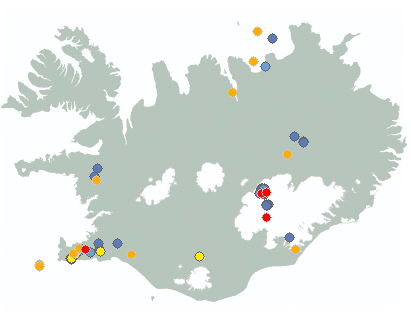Home-page - Icelandic Meteorological Office
Weather forecast
Weather forecast for the next 24 hours
South and southeast 3-10 m/s. Intermittent rain in the south and west, temperature 6 to 12 deg. C. Partly cloudy or fair in the northeast part with temperature up to 15 deg. C.
Lighter wind tomorrow and some rainshowers, but mainly dry in North- and East-Iceland.
Forecast made 26.04.2025 03:52
If the map and the text forecast differs, then the text forecast applies
Forecast for station - 1
Forecast for station - 2
Forecast for station - 3
Forecast for station - 4
Forecast for station - 5
Maximum wind in Iceland today
| Lowlands | |
|---|---|
| Highlands | |
|---|---|
Maximum and minimum temperature in Iceland today
| Lowlands | |
|---|---|
| Highlands | |
|---|---|
Maximum precipitation in Iceland today
| Lowlands | |
|---|---|
| Highlands | |
|---|---|
Maximum wind in Iceland during the last hour
| Lowlands | |
|---|---|
| Highlands | |
|---|---|
Maximum and minimum temperature in Iceland during the last hour
| Lowlands | |
|---|---|
| Highlands | |
|---|---|
Maximum precipitation in Iceland during the last hour
| Lowlands | |
|---|---|
| Highlands | |
|---|---|
Preliminary results
Earthquakes
Biggest earthquakes during the last 48 hours
| Size | Time | Quality | Location |
|---|---|---|---|
| 2.6 | 24 Apr 06:52:19 | Checked | 10.4 km NNW of Grímsfjall |
| 2.1 | 26 Apr 02:06:49 | 90.1 | 8.6 km ESE of Bárðarbunga |
| 1.9 | 24 Apr 06:51:42 | Checked | 9.6 km NNW of Grímsfjall |
Specialist remark
An earthquake, 3.1 in magnitude, was recorded near Grjótárvatn in Borgarfjörður at 09:47 on the 23rd of April. On the 15th of April, an earthquake, 3.7 in magnitude, was recorded which is the biggest earthquake since activity started in this area in 2021.
Written by a specialist at 23 Apr 13:26 GMT
Week overview -
Earthquake activity throughout the country is described in a weekly summary that is written by a Natural Hazard Specialist. The weekly summary is published on the web every Tuesday. It covers the activity of the previous week in all seismic areas and volcanic systems in the country. If earthquake swarms are ongoing or significant events such as larger earthquakes have occurred during the week, they are specifically discussed. More
Hydrology
Average flow and temperature last 24 hours
| River | Place | Flow | Water temperature |
|---|
Remarks of a specialist
Due to malfunction we have closed the service with the water stations on the map. In stead it is possible to see this in the link.
Rauntímavöktunarkerfi.
Written by a specialist at 04 Mar 11:42 GMT
Avalanches
Avalanche bulletins for selected areas
The avalanche bulletin is at a regional scale. It does not necessarily represent avalanche danger in urban areas.
| Region | Sat Apr 26 | Sun Apr 27 | Mon Apr 28 |
|---|---|---|---|
|
Southwest corner
|
|
|
|
|
Northern Westfjords
|
|
|
|
|
Tröllaskagi
|
|
|
|
|
Eyjafjörður (experimental)
|
|
|
|
|
Eastfjords
|
|
|
|
News
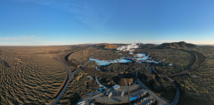
Uplift continues beneath Svartsengi but the rate has decreased
Update 22. April kl. 12:30 UTC
Uplift in Svartsengi continues, but the rate has significantly decreased and is now similar to the period before the eruption that began on April 1. As magma accumulation continues beneath Svartsengi, repeated magma intrusions and even eruptions in the Sundhnúkur crater row must be considered.
Read more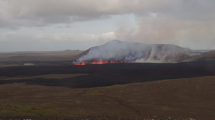
Uplift continues beneath Svartsengi
Updated April 8, at 16:15 UTC
Deformation measurements clearly show that uplift beneath Svartsengi is ongoing. The current uplift rate is faster than that observed following previous eruptions. This may be explained by the large volume of magma — around 30 million cubic meters — that was released from the system during the most recent event.
However, it is still too early to predict how the rate of magma accumulation will develop. Past events have shown that accumulation rates typically decline as more time passes between eruptions. At least a week, and possibly several weeks, will need to pass before we can evaluate if — and how — the rate of accumulation will change.
Read more
Eruption at the Sundhnúkur crater row remains likely
Updated 25. March at 15:00 UTC
GPS deformation data shows that magma continues to accumulate beneath Svartsengi, although the pace of land uplift has slightly decreased in recent weeks. Despite the slower uplift, experts still consider it likely that a magma intrusion and/or eruption will occur along the Sundhnúkur crater row.
Read more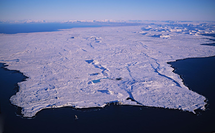
Earthquake swarm ongoing offshore Reykjanestá
At around 14:30 yesterday (12 March 2025), a rather intense earthquake swarm began offshore Reykjanestá. The swarm was most intense at the beginning when about 50 – 60 earthquakes were recorded in the first few hours. As the day progressed, the activity decreased but then increased again shortly before midnight when an earthquake of magnitude 3.5 occurred. When the activity increased again in the evening, it shifted slightly westward as the image shows (blue circles indicate the location of earthquakes that occurred at the beginning of the swarm yesterday, while yellow and red ones show earthquakes from late last evening and night).
Read more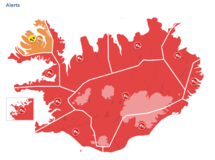
Red weather warnings in effect today – no travel recommended
A southerly storm or violent storm is expected later today and tomorrow, with very strong wind gusts, widely 35 – 45 m/s and especially near mountains, but locally exceeding 50 m/s. Considerable or heavy rain is expected in the south and the west regions of the country. More details can be found here.
Read moreThe weather in Iceland in 2024
The year 2024 was remarkably cold compared to temperatures of this century. The national average temperature was 0.8 degrees below the 1991 to 2020 mean, and it was the coldest year since 1998. Lowest relative temperature was inland in the North, while it was warmer along the southern coast. The summer was wet across the entire country, but other months of the year were relatively dry. Overall, the year was drier than average in the eastern, southern, and southwestern parts of the country, but wetter than average in the North and West, which experienced heavy rain during summer. The sea level pressure was unusually low from June through August, and the summer was characterized by frequent low-pressure system passage and unfavourable weather. During other seasons, the weather was relatively calm, and annual mean seal level pressure and wind speed were around average.
Read moreShort articles
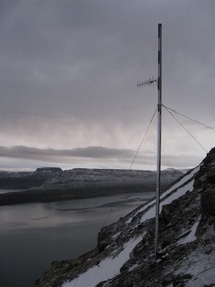
Avalanches in Iceland
Catastrophic avalanches in the villages Súðavík, 16 January 1995, and Flateyri, October 1995, which killed 34 people and caused extensive economic damage, totally changed the view regarding avalanche safety in Iceland.
New publications and research
- Michelle Parks, Freysteinn Sigmundsson, Vincent Drouin, Ásta R. Hjartardóttir, Halldór Geirsson, Andrew Hooper, Kristín S. Vogfjörð, Benedikt G. Ófeigsson, Sigrún Hreinsdóttir, Esther H. Jensen, Páll Einarsson, Sara Barsotti & Hildur M. Friðriksdóttir. (2023).
- Sahar Rahpeyma, Benedikt Halldórsson, Birgir Hrafnkelsson & Atefe Darzi. (2023). Frequency-dependent site amplification functions for key geological units in Iceland from a Bayesian hierarchical model for earthquake strong-motions.
- Sara Klaasen, Solvi Thrastarson, Yesim Cubuk-Sabuncu, Kristín Jónsdóttir, Lars Gebraad, Patrick Paitz & Andreas Fichtner. Subclacial volvano monitoring with fiber-optic sensing: Grímsvötn, Iceland. (2023).
- Ismael Vera Rodriquez, Marius P. Isken, Torsten Dahm, Oliver D. Lamb, Sin-Mei Wu, Sigríður Kristjánsdóttir, Kristín Jónsdóttir, Pilar Sanchez-Pastor, John Clinton, Christopher Wollin, Alan F. Baird, Andreas Wuestefeld, Beat Booz, Eva P.S.Eibl, Sebastian Heimann, Bettina P. Goertz-Allmann, Philippe Jousset, Volker Qye, Vala Hjörleifsdóttir, Anne Obermann. (2002).
- Lamb, O.D., Gestrich, J.E., Barnie, T.D., Jónsdóttir, K., Ducrocq, C., Shore, M.J., Lees, J.M., Lee, S.J (2022). Acoustic observations of lava fountain activity during the 2021 Fagradalsfjall eruption, Iceland. Bull Volcanol 84, 96. doi.org/10.1007/s00445-022-01602-3
- Freysteinn Sigmundsson, Michelle Parks, Andrew Hooper, Halldór Geirsson, Kristín S. Vogfjörd, Vincent Drouin, Benedikt G. Ófeigsson, Sigrún Hreinsdóttir, Sigurlaug Hjaltadóttir, Kristín Jónsdóttir, Páll Einarsson, Sara Barsotti, Josef Horálek & Thorbjörg Ágústsdóttir (2022). Deformation and seismicity decline before the 2021 Fagradalsfjall eruption. Nature 609, 523–528. doi.org/10.1038/s41586-022-05083-4
